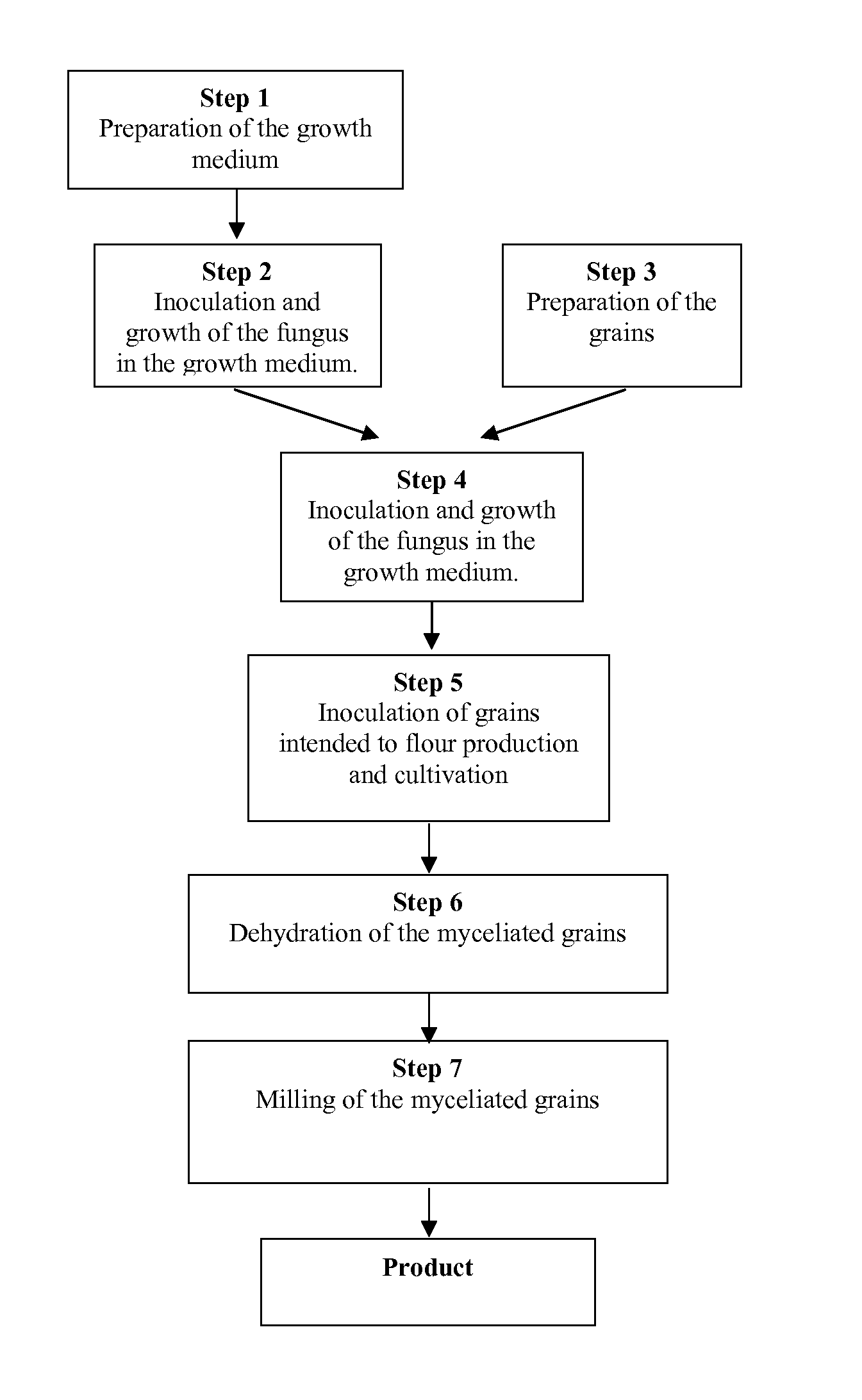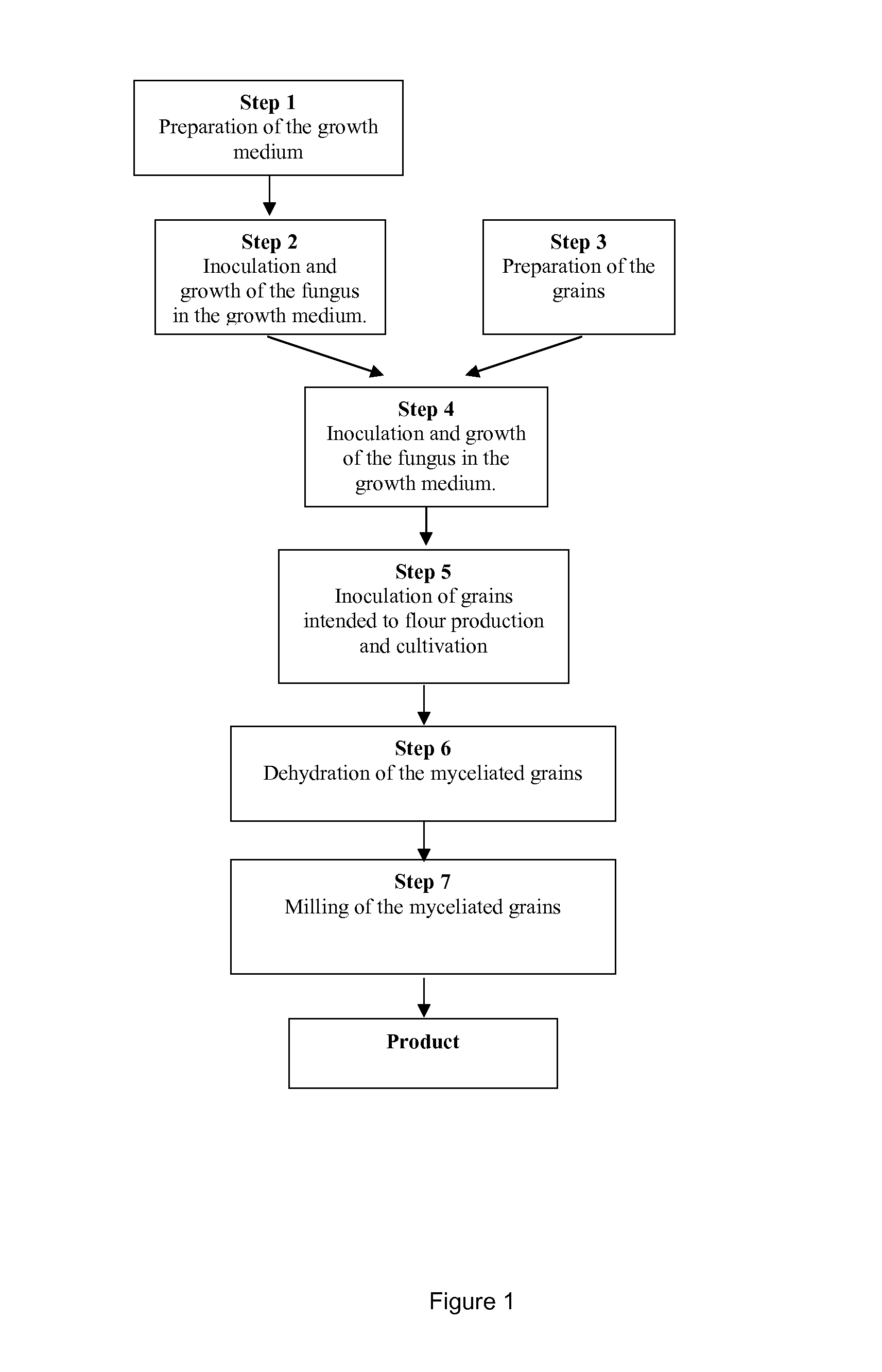Flours produced from fungus myceliated grain
a technology of mycelium fungus and flour, which is applied in the field of making flour, can solve the problems of increasing the cost of the end product, high cost, and inability to use them for the preparation of doughs and other traditional food products, and achieves the effect of high nutritional valu
- Summary
- Abstract
- Description
- Claims
- Application Information
AI Technical Summary
Benefits of technology
Problems solved by technology
Method used
Image
Examples
example 1
[0033]Emperor's flour (Farinha do Imperador)—flour produced from myceliated sorghum grains and the fungus Ganoderma lucidum for direct use in feeding.
[0034]Emperor's flour is related to the segment of food products and may be added to vitamins, porridges, yogurts, soups and the like or may be used as a raw material in the preparation of elaborate foods such as breads, biscuits, cakes, doughs, energy bars, etc. In addition to the enriched nutritional value, consumption of this flour may provide improved health. Scientific reports have shown that the fungus Ganoderma lucidum is a powerful ally in the treatment of several immune-related diseases, cancer and high cholesterol.
[0035]Fungi are considered a relatively expensive product to be added to basic foods, but when produced in large scale, as in the method for producing Emperor's flour, these values are sufficiently reduced to make viable their use in a competitive market, to make their nutritional values available and to allow the a...
example 2
[0040]Wheat flour with Ganoderma lucidum mycelium—flour produced from myceliated wheat grains and the fungus Ganoderma lucidum.
[0041]Wheat flour with Ganoderma lucidum has higher costs than Emperor's flour. Nevertheless, it has a wide use in processed foods as it is made from wheat grain and, when compared with the costs of the fungus, the use thereof is viable.
[0042]Wheat flour with Ganoderma lucidum, whose nutritional value and digestibility was improved by the addition of the fungus Ganoderma lucidum, is rich in fiber, containing 11% total dietary fiber, 0.70% being soluble fibers and 10.30% being insoluble fibers. It contains gluten.
[0043]Wheat flour with Ganoderma lucidum contains no cholesterol and has 2.6% total fats, which is a relatively low level. However, it should be noted that 61.5% of this fat is comprised of unsaturated fatty acids, mainly 1.17 g / 100 g linoleic acid (omega 6) 0.36 / 100 g oleic acid (omega 9) and 0.06 / 100 g omega 3, which is more desirable for consumpti...
example 3
[0045]Blazei Brazil Imperial Biscuits (Biscoitos do Imperador Blazei Brazil)—biscuit produced from sorghum enriched with mycelium mushroom of the legendary king.
[0046]The Imperial Cookies Blazei Brazil are a tasty example of the potential from the innovative Emperor's Flour produced from sorghum enriched with mycelium mushroom of the legendary king. It was idealized from the consumption of the legendary king by Chinese and Japanese, who considered it the “herb of longevity”, and from its nutritional and medicinal properties. This mushroom was preferably consumed by Chinese emperors because of food properties and rareness.
[0047]The Imperial Cookies are a sweet and tasty choice for those who have busy lives and seek convenience with balanced and nutritious diet. It is ideal for snacks at any time of day. The ingredients of Imperial Cookies are: tapioca flour, wheat flour, Emperor's flour, vegetable fat, cheese, eggs, coconut, sugar and salt. It also contains beta-glucan (β-1,3 and β-1...
PUM
 Login to View More
Login to View More Abstract
Description
Claims
Application Information
 Login to View More
Login to View More - R&D
- Intellectual Property
- Life Sciences
- Materials
- Tech Scout
- Unparalleled Data Quality
- Higher Quality Content
- 60% Fewer Hallucinations
Browse by: Latest US Patents, China's latest patents, Technical Efficacy Thesaurus, Application Domain, Technology Topic, Popular Technical Reports.
© 2025 PatSnap. All rights reserved.Legal|Privacy policy|Modern Slavery Act Transparency Statement|Sitemap|About US| Contact US: help@patsnap.com


